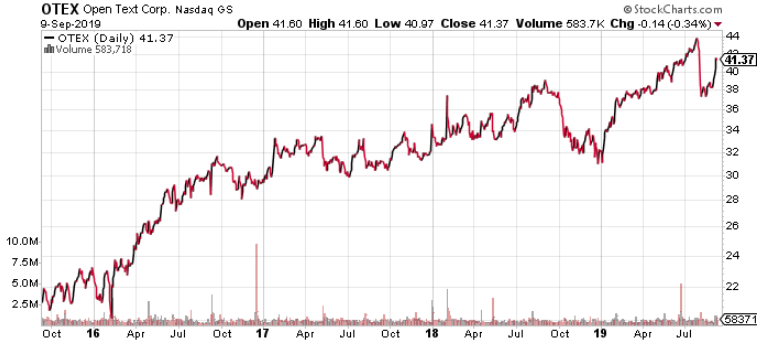Open Text Corp: 3 Reasons to Consider This Canadian Tech Stock
Marijuana Business, Stocks, Finance, & Investing September 11, 2019 MJ Shareholders 0


Looking to Make Money From Tech Stocks? Read This
For investors who want to make big capital gains from the stock market, the technology sector is one of the best places to look. With so many fast-growing companies coming out of Silicon Valley over the last few decades, the tech sector has made many investors rich.
But it’s worth noting that Silicon Valley—or even the whole United States, for that matter—is not the only place to find fast-growing tech companies. That said, I want to talk to you about a lesser-known tech stock-based north of the border: Open Text Corp (NASDAQ:OTEX).
Headquartered in Waterloo, Ontario, Canada, Open Text is in the enterprise information management business. It provides a wide range of software and services, helping companies manage, leverage, secure, and gain insight into their enterprise information. Open Text can deliver its solutions both on-premise or in the cloud.
Also, while Open Text Corp is listed on the Toronto Stock Exchange, its shares also trade on the Nasdaq. Therefore, it’s very convenient for American investors to get a piece of the action; on both stock exchanges, the company’s ticker symbol is “OTEX.”
As I said, there are plenty of exciting tech stocks in the U.S., so why should American investors consider a Canadian tech stock?
Well, in my opinion, there are three main reasons.
Open Text Corp Runs a Recurring Business
The first reason to consider OTEX stock lies in the recurring nature of the company’s business. You see, a tech company could be making a hot product, but if no one wants to buy that product more than once, it would only make money from one-time sales. And that would limit the company’s growth potential.
Hardware device makers often find themselves in that situation. For instance, GoPro Inc (NASDAQ:GRPO) was—and still is—one of the best makers of action cameras. But since people who want an action camera go out and buy one, the company couldn’t churn out the same growth rates continuously.
The lack of a recurring business at GoPro also made investors worried. Looking back, we see that, in the last five years, GPRO stock has plunged more than 90%. Ouch!
Therefore, it’s not an exaggeration to say that having a recurring business model is of utmost importance to a tech company’s investor appeal these days. The good news is, Open Text Corp has been running a recurring business.
When a company decides to use Open Text’s enterprise information management service, it’s not just buying a one-time product. Chances are the company will become a repeat customer of Open Text and pay it on a regular basis.
In its latest investor presentation, Open Text revealed that the company’s cloud-based services and subscriptions have renewal rates in the mid-90% range, and its on-premise customer support services have renewal rates in the low 90% range. (Source: “OpenText Investor Day,” Open Text Corp, September 6, 2019.)
Just take a look at the company’s top-line number and you’ll see the recurring nature of its business. In Open Text’s fiscal-year 2019, which ended June 30, the company generated almost $2.9 billion in total revenue. Notably, its annual recurring revenue was almost $2.2 billion. (Source: “OpenText Reports Fourth Quarter and Fiscal Year 2019 Financial Results,” Open Text Corp, August 1, 2019.)
Therefore, recurring revenue accounted for 75% of Open Text’s total revenue in its most recent fiscal year. For risk-averse investors, this should be a reassuring sign.
Open Text Corp Runs a Growing Business
The second reason why tech stocks are so popular is that they tend to deliver fast revenue growth. And on that front, Open Text stock does not disappoint.
Consider this: in Open Text’s fiscal-year 2014, its annual recurring revenue was less than $1.2 billion. In fiscal 2019, the company’s annual recurring revenue totaled almost $2.2 billion. So in just the last five years, Open Text has gone up by more than 80%.
And don’t think for one second that we are talking about some early-stage startup that is yet to report a positive number at the bottom line. Open Text Corp is already profitable.
In the company’s fiscal-year 2019, its adjusted net income came in at $2.76 per diluted share, representing a solid 7.8% increase year-over-year. On a constant currency basis, Open Text stock’s adjusted earnings came in at $2.79 per share, up a more impressive nine percent from a year ago.
One of the things that boosted this Canadian tech company’s bottom line over the years was its expanding margin. In the five-year period ended June 30, 2019, Open Text’s adjusted earnings before interest, tax, depreciation, and amortization (EBITDA) margin went from 33.1% to 38.4%, marking a 530-basis-point expansion.
Open Text Corp Returns Cash to Investors
The third reason why tech stock investors should check out Open Text is the company’s ability to return cash to investors. In particular, I’m talking about dividends.
Now, I know what you are thinking: in the tech stock world where double- and even triple-digit gains are possible, who cares about a few percents of dividend yield?
Well, the reality is, in this day and age, earnings can be adjusted, but dividends are still cold, hard cash paid to shareholders. If a company can maintain a solid dividend policy, it sends a more clear message about the state of its business.
Plus, when an investor buys shares of a company, there is usually an expectation that the company will start returning profits to investors at some point.
Of course, companies can also use the profits to buy back their stock. But keep in mind that buybacks are usually at the discretion of management, meaning there is no guarantee on how many shares a company will actually repurchase.
Dividends, on the other hand, represent a more certain way of returning cash to investors. When a company sets up a regular dividend policy, the expectation is that it will keep paying at least this amount going forward. Having a dividend obligation could also provide more discipline on how management allocates the company’s cash.
Right now, Open Text has a quarterly dividend rate of more than $0.17 per share, which translates to an annual yield of 1.7%. Looking back, we see that, since the company started paying regular cash dividends in 2013, its quarterly cash payout per share has grown by 132.8%. (Source: “Dividend History,” Open Text Corp, last accessed September 10, 2019.)
The neat thing is, despite more than doubling its payout in the past six years, Open Text was paying out just a small amount of its profits.
For instance, in its most recent fiscal year, the company earned an adjusted net income of $2.76 per share while declaring and paying total cash dividends of $0.63 per share. In other words, OTEX stock was paying out less than one quarter of its profits. (Source: Open Text Corp, August 1, 2019, op cit.)
Another reason the company can deliver this kind of dividend growth is its ability to generate cash from its operations. From its fiscal-year 2014 to fiscal-year 2019, Open Text’s annual operating cash flow has increased by 110%. (Source: Open Text Corp, September 6, 2019, op. cit.)
Open Text Corp (NASDAQ:OTEX) Stock Chart
Chart courtesy of StockCharts.com
Analyst Take
Like most tech stocks, Open Text Corp has seen some volatility in its share price. But overall, the company has been travelling on a rather impressive uptrend. In the last four years, Open Text stock has surged more than 80%.
Given the company’s recurring business, growing profits, and shareholder-friendliness, I wouldn’t be surprised to see more tech stock investors warming up to OTEX stock in the years ahead. As it stands, Open Text deserves a serious look.
MJ Shareholders
MJShareholders.com is the largest dedicated financial network and leading corporate communications firm serving the legal cannabis industry. Our network aims to connect public marijuana companies with these focused cannabis audiences across the US and Canada that are critical for growth: Short and long term cannabis investors Active funding sources Mainstream media Business leaders Cannabis consumers











No comments so far.
Be first to leave comment below.